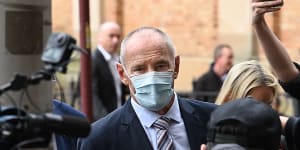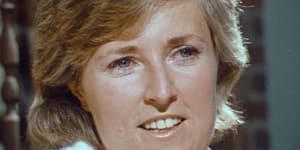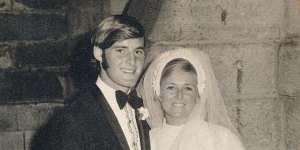Justice Ian Harrison,who took almost five hours to hand down his verdict in the murder trial,told the NSW Supreme Court he was satisfied that Lynette Dawson was dead and “did not voluntarily abandon her home”.
On Tuesday,seven weeks after the trial ended,the judge found Dawson guilty of murder and said Dawson’s lies demonstrated a consciousness of guilt. He also found Dawson had “resolved to kill his wife”.

Chris Dawson arrives at court on Tuesday morning for the announcement of his verdict.Kate Geraghty
Dawson,74,faced a judge-alone trial during which his lawyers argued it was possible Lynette abandoned her young daughters and the family’s Bayview home in January 1982. She was 33 at the time and her body has never been found.
Harrison began delivering his judgment at 10am on Tuesday,when he said he was satisfied Lynette Dawson died on or about January 8,1982,and that none of the alleged sightings of her in following years were genuine.
He added that Lynette had a “strong maternal bond with her daughters”,relied on her husband to drive her,did not pack a bag and there was “scant evidence” she had access to funds to start a new life.
Chris Dawson has been found guilty in the murder trial of his wife Lyn.
Harrison said in that context it was hard to accept the theory that she had “walked out of her life”.
The Crown had alleged Dawson killed his wife and disposed of her body,possibly with assistance,to have an unfettered relationship with a teenage babysitter and his former student,known as JC.
The disappearance was the subject of a 2018 podcast by investigative journalist Hedley Thomas calledThe Teacher’s Pet,which attracted a global audience to the case.

Lynette Dawson on ABC’s Chequerboard program in 1975.NSW Supreme Court/ABC
JC told the trial that Dawson would leave love notes in her schoolbag,signing some off as “God” to disguise himself.
She moved into his home during her HSC year in October 1981,but moved out the following month,after she said she was confronted by Lynette who said “you’ve been taking liberties with my husband”.
Shortly before Christmas 1981,Dawson and JC left Sydney intending to start a new life together in Queensland,before the teenager wanted to return.
The court heard Chris and Lynette attended counselling on January 8,1982. Lynette’s colleague Annette Leary gave evidence Lynette had told her that in the lift to counselling,Chris grabbed her around the neck and said “if this doesn’t work,I’m getting rid of you”.
Chris Dawson has arrived at NSW's Supreme Court in Sydney,where he will learn the verdict in a trial concerning the death of his wife Lynette in 1982.
“I strongly dispute that because ... that particular day was starting with the hope of saving something which after 13 years was very much floundering,” Dawson told police in 1991.
While delivering his verdict,Harrison said he was satisfied beyond reasonable doubt that Dawson’s reported telephone calls from Lynette after January 9,1982,“are lies”.
He said he did not accept that a woman allegedly determined to abandon her home and family and “disappear from sight” would have contacted the very person who was claimed to be “the reason for her departure”.
“It defies common sense,” the judge said.

Harrison said he had reached the conclusion that “Lynette Dawson did not leave her home voluntarily”.
He pointed to Dawson’s own concession in his police interview that Lynette only contacting him,and no other family or friends,was “extremely strange”.
Harrison said he was satisfied beyond reasonable doubt that Lynette “never telephoned Mr Dawson after January 8,1982”.

Chris and Lynette Dawson at their wedding in 1970.Supplied:NSW Supreme Court
JC claimed that in late 1981,Dawson had parked his car outside a building while she waited inside wearing her school uniform. She alleged he later told her,“I went inside to get a hitman to kill Lyn,but then I decided I couldn’t do it because innocent people could be hurt”.
Dawson told police this was a “complete and utter fabrication”.
The defence suggested JC was on a mission to destroy Dawson and had only raised the allegation amid a bitter custody battle after their separation in 1990,having married him in January 1984.
The trial also heard from Dawson’s former Newtown Jets teammate Robert Silkman,who claimed Dawson had asked him on the plane back from an end-of-season trip in 1975 “if he knew anyone who could get rid of his wife”.
The defence argued there was the possibility that Lynette “abandoned the home of her own accord”,and relied on several phone calls Dawson claimed he had received and multiple reported sightings.
Dawson said he had dropped Lynette off at a Mona Vale bus stop to go shopping on January 9,1982,but instead of meeting him at the Northbridge Baths later that day,she had called to say she “needed time away”.
Chris Dawson to learn today whether he will be jailed for the murder of his wife.
Harrison said on Tuesday he was unable to accept that the version of events suggesting Dawson received an STD call from Lynette that afternoon “could reasonably be true”.
“I’m satisfied beyond reasonable doubt that Mr Dawson’s various representations that he spoke to Lynette Dawson by telephone on a call made to the Northbridge Baths on that day is a lie,” he said.
Crown prosecutor Craig Everson,SC,had argued that one of the dominoes in Dawson’s plan was to have family friend Phillip Day and Lynette’s mother Helena Simms as witnesses to his receipt of the alleged phone call and someone to mind his two daughters that night who had also been at the pool.
Everson said Dawson’s “engineered window of quiet seclusion” gave him the opportunity to dispose of a body before making his way north to collect JC from her holiday at South West Rocks.
The prosecutor said it “beggars belief” that Dawson would have then brought JC into his matrimonial home “if he honestly,truthfully believed” his wife was returning within a few days.
JC said Dawson told her “Lyn’s gone,she’s not coming back” and the wardrobe had been bursting with clothes. She said her diamond ring was later made “using the diamonds from Lyn’s engagement ring and eternity ring” left in the house.
Dawson reported Lynette missing on February 18,1982. The Crown alleged that a newspaper advertisement about her disappearance,placed in March,was part of Dawson’s “ongoing,deceptive attempts to present himself as a deserted husband”.
Defence barrister Pauline David,who has since been sworn in as a judge of the NSW District Court,said Dawson gave his wife a reason to not want to be with him when he left their home with JC.
She said Dawson was at a significant forensic disadvantage regarding bank card and phone records,submitting that those that might have supported that Lynette was alive in the early months of 1982 were unavailable due to the passage of time.
David grilled police witnesses over their investigations,suggesting deliberate omissions were made.
Lynette was allegedly sighted at a Central Coast fruit shop,outside Gladesville Hospital,on Macquarie Street in the city during a royal visit in March 1983 and at the former Rockcastle Hospital in June 1984,although five nurses gave evidence they had never worked with someone by that name.
Harrison said he was satisfied that none of the alleged sightings “was a genuine sighting of Lynette Dawson”.
Our Breaking News Alertwillnotify you of significant breaking news when it happens..